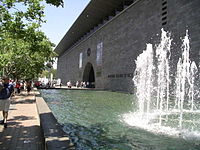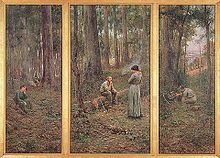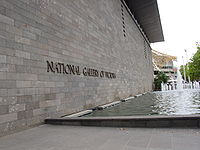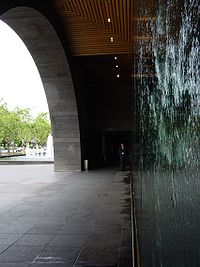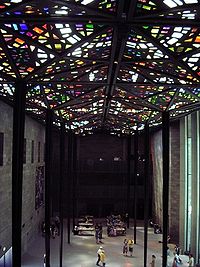- National Gallery of Victoria
-
Coordinates: 37°49′21″S 144°58′07″E / 37.822595°S 144.968634°E
National Gallery of Victoria 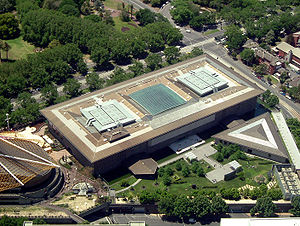
Established 1861 Location Southbank, Victoria, Australia Type Art gallery Visitor figures 1,650,000 (2006/2007) [2] Director Gerard Vaughan Public transit access Flinders Street Station
Tram routes 1, 3, 5, 6, 8, 16, 64, 67, 72Website http://www.ngv.vic.gov.au The National Gallery of Victoria is an art gallery and museum in Melbourne, Australia. Founded in 1861, it is the oldest and the largest public art gallery in Australia. Since December 2003, NGV has operated across two sites. The main gallery, known as NGV International, is located on St Kilda Road, in the heart of the Melbourne Arts Precinct of Southbank, with a branch gallery at Federation Square. The St Kilda Road Gallery, designed by Sir Roy Grounds, opened in 1968. and redesigned by Mario Bellini. The Ian Potter Centre: NGV Australia at Federation Square was designed by LAB Architecture Studio.[1]
At the time when the gallery opened, Victoria was an independent colony for just ten years, but in the wake of the Victorian gold rush, it was easily the richest part of Australia, and Melbourne the largest city. Besides donations of works of art, donated funds from wealthy citizens have been used by the Gallery to purchase large collections of overseas works from both old and modern masters. The Gallery currently holds over 65,000 works of art.[2] The Felton Bequest, established by the will of Alfred Felton, has acquired and donated over 15,000 works of art to the Gallery.
The National Gallery of Victoria Art School, associated with the gallery, was founded in 1867. It was the leading centre for academic art training in Australia until about 1910.[3] The School’s graduates went on to become some of Australia’s most significant artists.
Contents
Heidelberg era
In the late 19th and early 20th century, domestic art began to thrive (particularly with the "Heidelberg School" in what was then an outer suburb of Melbourne) and the National Gallery was well-placed to add an excellent collection of key Australian works, which trace the metamorphosis of imported European styles into distinctively Australian art. One of the most famous works at the gallery is The pioneer by Frederick McCubbin (1904).
Collection
The International Collection includes works by Gian Lorenzo Bernini, Marco Palmezzano, Rembrandt, Peter Paul Rubens, Giovanni Battista Tiepolo, Tintoretto, Paolo Uccello, and Paolo Veronese, amongst others. In the Modern collection, the gallery has continued to expand into new areas, becoming an early leader in textiles, fashion, photography, and Australian Aboriginal art. Today it has strong collections in areas as diverse as old masters, Greek vases, Egyptian artifacts and historical European ceramics, and the largest and most comprehensive range of artworks in Australia.[citation needed]
An important recent addition to the collection is "The Rest on the Flight Into Egypt with Saint Catherine and Angels" by Paris Bordone. The purchase price was $3.8 million, the largest amount ever paid for a painting in the NGV collection.[4]
As a "National Gallery"
The gallery's name has caused some confusion over the years, as Victoria is not, and never has been a nation, but a state of Australia, and there is also the National Gallery of Australia (NGA) in Canberra. Some people, such as the chairman of the NGA, have called for the NGV to be renamed, perhaps to "Melbourne Gallery". However, the NGV was founded some 40 years before the founding of the Commonwealth of Australia, when Victoria was a self-governing British colony; the name alludes to that period, when Victoria was a discrete political entity. It was also established more than a century before the National Gallery in Canberra. According to former Victorian Premier Steve Bracks, "We won't be renaming the National Gallery of Victoria. It has a great tradition. It is the biggest and best gallery in the country and it's one of the biggest and best in the world."
Ian Potter Centre and NGV International
In 1959, the commission to design a new gallery and cultural centre was awarded to the architectural firm Grounds Romberg Boyd. In 1962, Roy Grounds split from his partners Frederick Romberg and Robin Boyd, retained the commission, and designed the gallery at 180 St Kilda Road (now known as NGV International). The building was completed in December 1967[5] and opened on 20 August 1968. One of the features of the gallery buildings are famous for is the Leonard French ceiling, one of the world's largest pieces of suspended stained glass. The ceiling casts colourful light on the floor below. Grounds subsequently designed the adjacent Victorian Arts Centre with its iconic spire.
The gallery is now spread over two buildings a short distance from each other at the southern end of the CBD. A new space, The Ian Potter Centre, in Federation Square opened in 2003 and houses the Australian art collection. Grounds' building just south of the Yarra River now houses the international collection. It reopened in December 2003 after four years of renovations by architect Mario Bellini.
The iconic Angel sculpture by Deborah Halpern was removed to be restored and relocated to Birrarung Marr. The Australian collection includes a large number of works donated by Dr. Joseph Brown in 2004, which forms the Joseph Brown Collection.
Picasso theft
A famous event in the history of the gallery was the theft of Pablo Picasso's painting "The Weeping Woman" in 1986 by a person or group who identified themselves as the "Australian Cultural Terrorists". The group took the painting to protest the perceived poor treatment of the arts by the state government of the time and sought as a ransom the establishment of an art prize for young artists. The painting was returned in a railway locker a week later.[6]
Blockbusters
The National Gallery of Victoria has held several large exhibitions known as "blockbusters", starting with Impressionists: Masterpieces from the Musee d'Orsay in 2004, and an exhibition of Dutch masters in winter 2005 with Vermeer's painting The Love Letter from the Rijksmuseum in Amsterdam exhibited among many others. It was the first time a Vermeer painting had been exhibited in Australia. There was also an exhibition of Caravaggio paintings in 2004.
The 2006 Melbourne Winter Masterpieces exhibition was titled Picasso: Love and War 1935-1945 and ran from 30 June 2006 and 8 October 2006. The exhibition of over 300 Picasso drawings and paintings from the years 1935-1945 was curated by Anne Baldassari, Director of the Musée Picasso, Paris.[7]
The 2007 Melbourne Winter Masterpieces exhibition was titled "Guggenheim Collection 1940s to now" (30 June to 7 October 2007) and showed more than 85 works by 68 artists, mainly from the Solomon R. Guggenheim Museum, New York City, but also from other Guggenheim Museums in Venice, Bilbao, and Berlin. The exhibition did not travel to any other city; it was seen by more than 180,000 visitors.[8][9]
The 2008 Melbourne Winter Masterpieces exhibition was titled "Art Deco 1910—1939" and ran from 28 June to 5 October 2008. The exhibition was organized by the Victoria and Albert Museum, London.[10]
The 2009 Melbourne Winter Masterpieces exhibition was titled "Salvador Dalí Liquid Desire" and ran from 13 June to 4 October 2009.[11]
The 2011 Melbourne Winter Masterpieces exhibition was titled "Vienna Art and Design" and ran from 13 June to 4 October 2011.[12]
Directors of the NGV
Directors of the NGV since its inception:[13]
- G. F. Folingsby, 1882–91
- Lindsay Bernard Hall, 1891-35
- William Beckwith McInnes, (acting) 1935-36
- P. M. Carew-Smyth, (acting) 1937
- J. S. Macdonald, 1936–41
- Daryl Lindsay, 1942–55
- Eric Westbrook, 1956–73
- Gordon Thomson (administrator), 1973–74
- Eric Rowlison, 1975–80
- Patrick McCaughey, 1981–87
- Rodney Wilson, 1988
- James Mollison, 1989–95
- Timothy Potts, 1995–98
- Gerard Vaughan, 1999-
References
- ^ NGV Annual Report - 2009/10.
- ^ [1]
- ^ McCulloch, Alan; Susan McCulloch (1994). The Encyclopedia of Australian Art. Allen & Unwin. p. 864 (Appendix 8). ISBN 1863733159.
- ^ Information at NGV web site
- ^ Green, Louise McO.. "NGV Women's Association History". National Gallery of Victoria. Archived from the original on 2007-08-30. http://web.archive.org/web/20070830201532/http://www.ngv.vic.gov.au/ngvwa/history.html. Retrieved 2007-12-22.
- ^ Justin Murphy; Susan Cram (19 September 2004). "Stolen Picasso". Rewind (ABC TV). Australian Broadcasting Corporation. http://www.abc.net.au/tv/rewind/txt/s1199862.htm. Retrieved 10 September 2010.
- ^ "Arts Victoria - Melbourne Winter Masterpieces". http://www.arts.vic.gov.au/content/Public/About_Us/Major_Projects_and_Initiatives/Melbourne_Winter_Masterpieces.aspx.
- ^ "Guggenheim Collection: 1940s to Now". NGV. 2007. Archived from the original on 2007-09-27. http://web.archive.org/web/20070927010236/http://www.ngv.vic.gov.au/guggenheim/. Retrieved 2007-10-10.
- ^ "Guggenheim leaves Melbourne". Entertainment Depot, Australia. 8 October 2007. http://www.entertainmentdepot.com.au/news/guggenheim-leaves-melbourne/. Retrieved 2007-10-10.
- ^ "Art Deco". NGV. 2008. http://www.ngv.vic.gov.au/artdeco/. Retrieved 2009-06-10.[dead link]
- ^ "Salvador Dalí". NGV. 2009. http://www.ngv.vic.gov.au/dali/. Retrieved 2009-06-10.[dead link]
- ^ "Vienna". NGV. 2011. http://www.ngv.vic.gov.au/vienna/. Retrieved 2011-06-10.
- ^ Alan McCulloch, Susan McCulloch and Emily McCulloch Childs, The New McCulloch's Encyclopedia of Australian Art (4th edition), Aus Art Editions & Miegunyah Press, 2006, p. 458.
External links
Categories:- Landmarks in Melbourne
- Art museums and galleries in Melbourne
- Buildings and structures in Melbourne
- Heritage listed buildings in Melbourne
- Buildings and structures completed in 1968
- Modernist architecture in Australia
- Brutalist architecture in Australia
Wikimedia Foundation. 2010.


